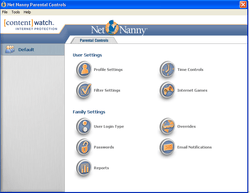Net Nanny
 | |
|
The Net Nanny 6 interface, shown on a computer running Windows XP. | |
| Developer(s) | ContentWatch, Inc. |
|---|---|
| Stable release |
7 (Windows) 3.0 (Mac)
|
| Operating system | Microsoft Windows, Apple OS X, iOS and Android |
| Type | Content Control |
| License | Proprietary EULA |
| Website | Net Nanny Homepage |
Net Nanny is a brand of content-control software marketed primarily towards parents as a way to control a child's computer activity. The flagship product allows a computer owner to block and filter Internet content, place time limits on use, and block desktop PC games.[1]
History
The original version of Net Nanny was released in 1995. It was developed, created and branded by Gordon Ross in mid 1994 after viewing a sting operation on a pedophile soliciting a child in a chat room. Ross saw a need that society would require an internet protecting service in the new age of the Internet. Net Nanny was the world's first Internet Filtering software for PC's. It was designed so the User/Owner of the computer could take control of what information was to be received or sent from a PC. It was designed to keep families and individuals relatively safe when surfing the Net, but more importantly it was designed so freedom of speech and choice would be kept alive on the Internet. Late 2002 it was sold to BioNet Systems who in turn sold it to Looksmart technologies in April 2004. In January 2007, it was purchased by ContentWatch, Inc.[2]
Reviews
TopTenReviews.com rates Net Nanny as #1 in "Internet Filter Software",[3] and "Best Parental Software".[4]
Consumersearch.com ranks it amongst the top 3 best Parental Control Software.[5]
See also
- List of content-control software
- Cyclope-Series
References
- ↑ "Internet Safety with Net Nanny Content Filtering Software". Retrieved 2009-03-20.
- ↑ Rubenking, Neil (2008-02-01). "11 Critical Security Apps - Net Nanny". Ziff Davis, Inc. Retrieved 2008-10-27.
- ↑ 2014 BEST Internet Filter Software Review - Product Comparisons
- ↑ 2014 Best Parental Software Reviews and Comparisons
- ↑ Top 3 best reviewed
